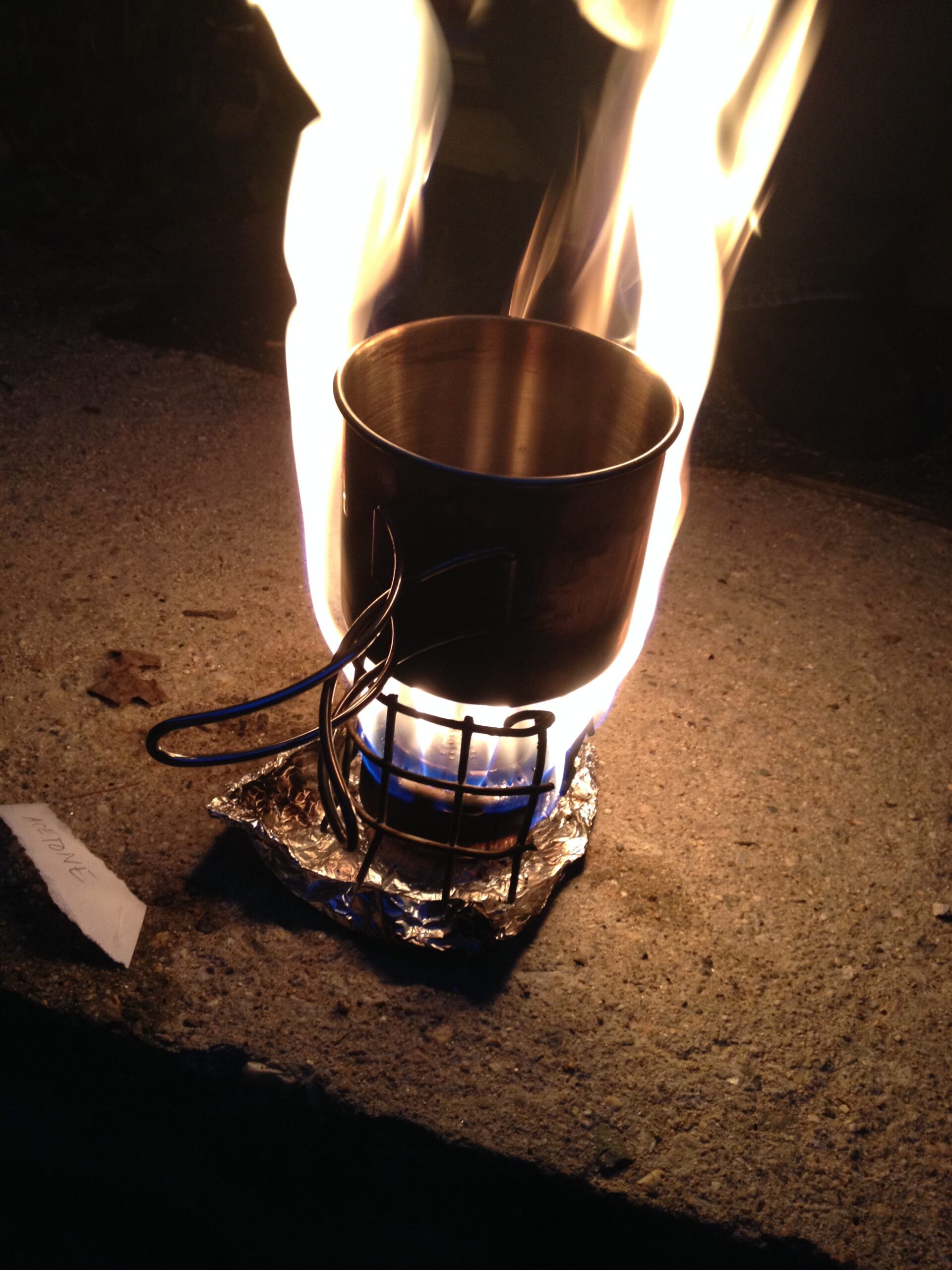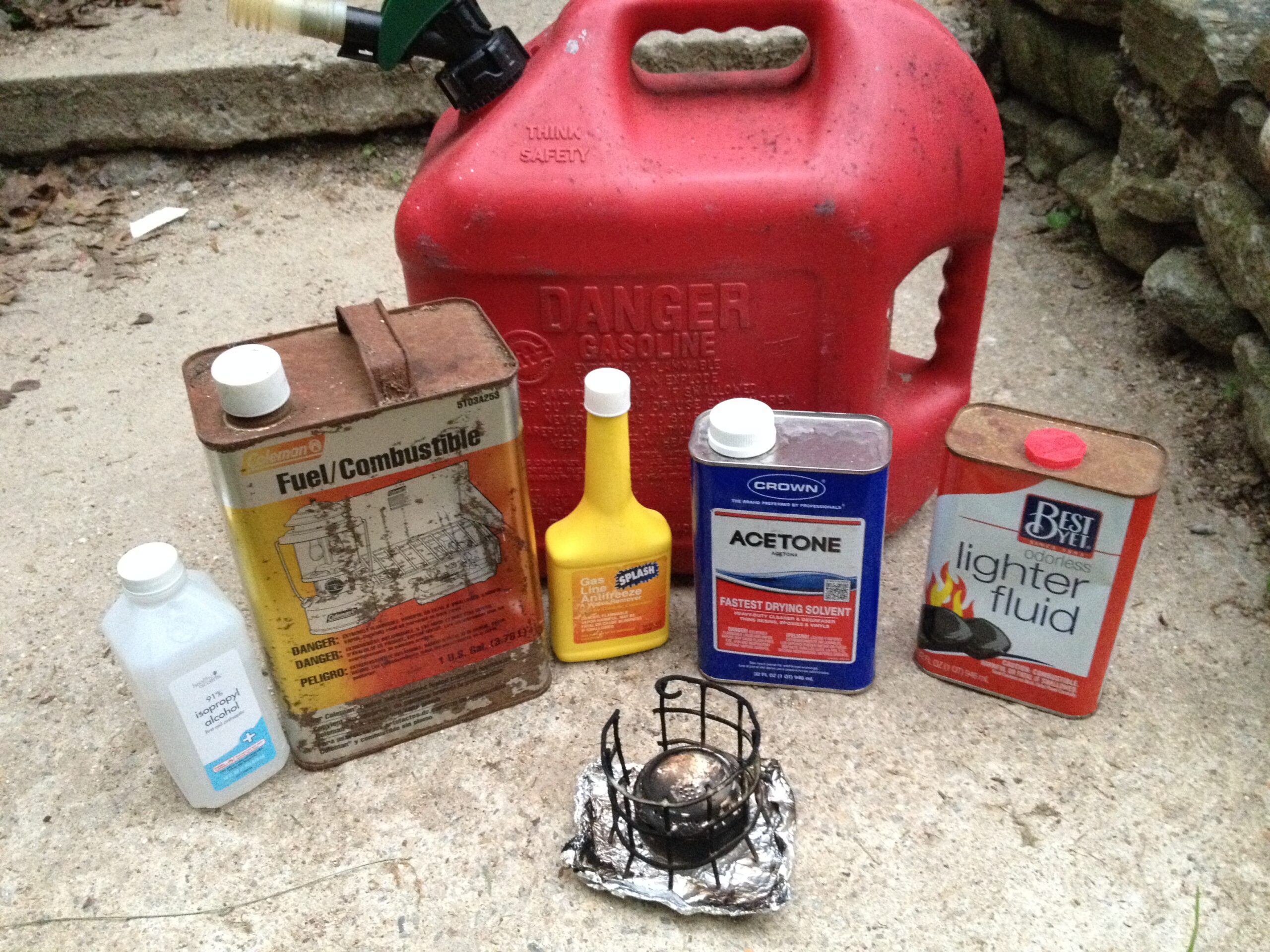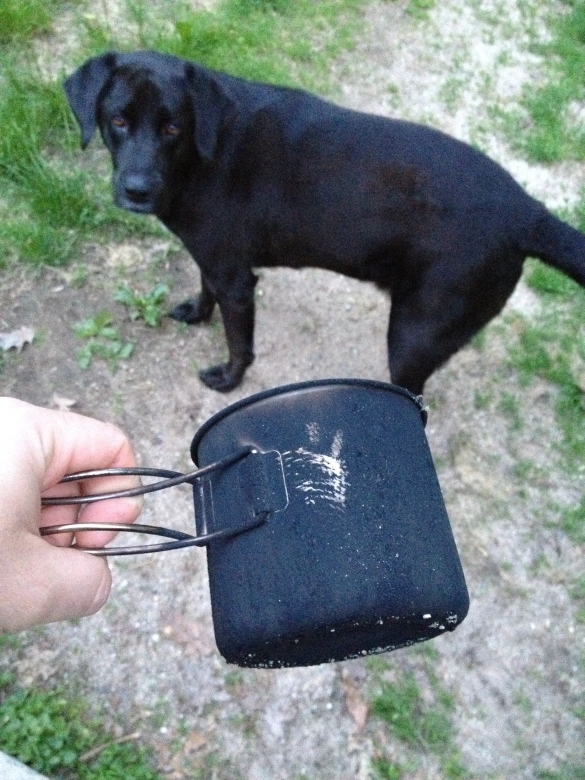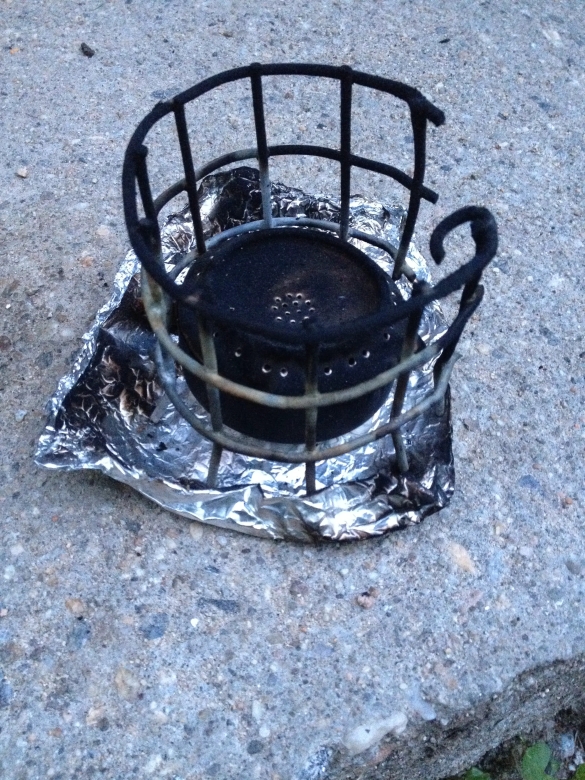I’ll admit it, I’m a cheapskate. But for good reason…I cheap out on a lot of things so that I can have really really good stuff in other areas. For instance, I’ll eat store-brand taco shells for dinner and have peanut butter sandwiches for lunch so that I can afford that Troy free-floating battlerail for my AR. (review soon). I’ll buy eight-packs of t-shirts at Wal-Mart so I can get the BF Goodrich AT tires for my Tacoma. It’s pretty simple, and I’m sure everyone here does it to some degree when it comes to their gear. However, there was this one time I cheaped out on gear, and it actually worked out pretty damned well.
I was looking for a good portable stove for my BOB about a year ago. Hoping for reviews or ideas, I checked the search function here on the blog to see if Jarhead Survivor or Calamity Jane might have tried one that worked well. Hopefully it wasn’t exactly pricey! A search found this article by Jarhead Survivor, circa 2010: “How to Build Your Own Alcohol Stove” BAM! I was pretty tickled pink. I’m the kinda guy who would much rather build something that works well on the cheap (and learn something along the way!) than spend money on something that came off a shelf with nothing but the side of its box to tell me about it. As a bonus, this particular alcohol stove was pretty cheap: its cost was two previously enjoyed frosty beverage cans, (of the red, white, and blue 16-oz. variety…I don’t drink that sissy Coke Zero stuff like Jarhead used in his article.), a handful of pink R-19 insulation (nabbed from my attic roof), a razorblade, and a thumbtack. For fuel, Jarhead used HEET gas line antifreeze (as a side note, ONLY USE THE YELLOW BOTTLED HEET! The red bottle has fuel injector cleaners that are poisonous when burned.). I whipped up a couple…and you know what? They worked pretty well! I’ve used mine quite a bit over the past year, and I have mostly good stuff to say about them. They are extremely lightweight, take up very little room, and they will heat up a cup of water for coffee or soup with no problem. Downsides? They get HOT, and you need to pay attention to that – but I guess that’s a natural byproduct of fire in general, huh? They need something stable and flat to sit on, especially in snow. I found that out here:

Yep, this definitely melted through the snow and fell over. Bogus. Shoulda been smarter than that! If the platform they are on (a large rock, for instance) isn’t relatively flat and level, the top-heavy container of water perched above the stove can (and probably will) tip over. If all you have is a couple cups of water you were able to filter out of a less-than stellar-looking bog hole, and you REALLY need it, your day will be instantaneously ruined by the lack of forethought to find a flat surface.
The last thing I didn’t like about it was not really a big deal; you have to accept it, since it comes with the territory of having such a small, DIY stove: it only burns for a few minutes, and then you have to let it seriously cool before you fill it, lest you find yourself in close proximity to a small aluminum grenade you made yourself. But, like I said, you have to accept it; it’s the trade-off for spending approximately zero dollars, and having an extremely portable, lightweight stove.

Maximizing my stove
I know Jarhead said to use HEET, and that’s what I had been using. But a quick perusal of all the flammable shit I had in my shed made me think there MIGHT be a different fuel out there that might burn more efficiently. So, by God, I went all Mythbusters on it and brought in a bit of science. I measured how much fuel my little stove could handle (about four tablespoons) and decided on this course of action: Use equal amounts of different fuels (all readily-available flammables people might find in abandoned sheds or homes) and use it with my stove setup (the very one I carry in my BOB) to see how long it A) takes to boil a pre-determined amount of water (One cup) and B) burns for. So, armed with a bunch of stuff that could burn me, a pad of paper, a pen, and the stopwatch on my iPhone, I set up on my concrete front steps to see what I could find out.

What did I find out? Well, for one, they all worked with the stove, and none of them kersploded it, leaving little pieces of Pabst can in my face. Some definitely worked better than others, and some burned cleanly, some were a mess. They all ignited very easily with one or two strokes of my FireSteel GobSpark Armageddon. Some of these (like the gasoline) will melt through plastics, requiring you to put a bit of thought into your container if you decide to carry them.
Results
For this test, I used 87-octane gasoline (don’t tell my wife I was supposed to mow the lawn with it.) white gas (or “Coleman fuel”…as most of Coleman’s products run on this stuff or propane.), 91% Isopropyl (rubbing) alcohol, Gas-Line Antifreeze (HEET), Charcoal Lighter fluid, and acetone. Ambient temperatures were about 50 degrees, and the only casualty was a ferociously stupid june bug that flew at high velocity right into the stove…I may have lost a few eyebrow hairs too, but such is the price I pay for science. Here are my notes on the various fuels…”Boil” was a nice rolling boil, “burned out” was the flame COMPLETELY out. Again, I used four tablespoons (two ounces) of fuel per test. Don’t tell my wife I used her cooking measuring stuff, okay?
GASOLINE: One strike with firesteel, explosive! (there was a fun fireball with this one, boys and girls! Be careful!). Large, dirty burning, orange flame about 12″ high. TIME TO BOIL: Didn’t boil a cup of water (!), burned out in 5 minutes, 32 seconds.
WHITE GAS: One strike with firesteel, burned quickly, with a nice flame. TIME TO BOIL: 2 minutes 42 seconds, burned out in 5 minutes, 8 seconds.
91% RUBBING ALCOHOL: Two strikes to ignite with firesteel, burned very evenly, very cleanly. Blue/white flame. TIME TO BOIL: 3 minutes 10 seconds, burned out in 9 minutes, 4 seconds.
LIGHTER FLUID: 2 strikes with firesteel, large orange smelly flame. Very sooty! TIME TO BOIL: 3 minutes, 11 seconds, burned out in 5 minutes, 29 seconds.
HEET: One strike to ignite, nice blue/yellow flame. Burned pretty cleanly. TIME TO BOIL: 3 minutes, 26 seconds, burned out in 6 minutes, 48 seconds.
ACETONE: two strikes with firesteel to ignite, clean fast burn. TIME TO BOIL: 2 minutes 43 seconds, burned out in 4 minutes 6 seconds.


Conclusions
As you can see, things got rather dirty. I noticed the petroleum-based products (gasoline, lighter fluid) burned very high, sooty flames. (No, they didn’t turn the dog black.) There was a lot of nasty soot and residue left over on the stainless cup and the stove, which were absolutely appalling to remove from anything it touched – clothes, fingers, skin. Additionally, they didn’t burn that efficiently – hell, the gasoline didn’t even boil water. It could be used to cook or heat, I suppose, but truthfully, I wouldn’t want whatever that stuff was all over the cup and stove to be all over my food. So, in a last-ditch case, it will work, but I’d keep looking for the other products if I could.
Alcohol based fuels did the job much better. They burned hotter (blue flames) and cleaner (very little residue on the stove and cup), and longer, with the champion going to the 91% rubbing alcohol. This bad boy burned hot for over nine minutes on 2 ounces of fuel, trumping the others by over 30%. As an added bonus, it’s VERY inexpensive and easy to find (about 2 bucks a bottle or less at pretty much ANY grocery store or drugstore) and it can be used to clean wounds and disinfect.
I still use the HEET (since I have it) but once it runs out (or I say “screw it” and use it for its actual intended purpose of keeping water out of my vehicle’s fuel tanks), I’ll be carrying around a bottle of 91% Isopropyl rubbing alcohol in my BOB for fuel. I’ll have to make another little DIY stove after all this testing and use…but it’s given me a year’s worth of service after spending about 10 cents for it. I think it deserves the retirement.
What do you guys think? Was this a fool’s errand? I liked this test because it worked with a VERY inexpensive tool that is extremely useful within its limitations, and it uses materials that can readily and easily be scrounged, even in a down-and-dirty SHTF environment/situation. Would you rather carry around a bottled-fuel stove? Or do you just go old-school and make fires?
Stay safe!
- Drew Forge
22 comments
Good timing on the post. Had made the stove a while ago, but was unhappy with how much I had to preheat it to get to start using heet and denatured alcohol, felt like it took almost as much energy to preheat the stove as you got out of it once it was going. This motivates me to try some rubbing alcohol and experiment a little more before buying something ready made.
in the Marine world (boat, not soldier) we often use alcohol stoves.. even ovens! Normally we use denatured alcohol bought at the big box for about $15/gal or less. burns quite well, little to no soot depending on brand, and fairly inexpensive compared to all the others.
for an example and specs of a non-pressurized alcohol stove design (for a boat, not BOB!) https://www.defender.com/product3.jsp?path=-1|2276204|2276209|2276214&id=60257
I was going to experiment on some cans of green chillies.
I’ll try it with tuna cans and Pabst cans now too. (now, where did I leave that rim cutting can opener?) fire. yeh, Fire, heh heh….
… and yeh, what Chuck said. (see below)
and regarding the singed eyebrows, that is one of the many reasons they tell you not to try burning gasoline in a kerosene heater.
it’s good that you have now demonstrated why not to use gasoline in an alcohol stove also.
I’ll admit, it was a little poetic license and exaggeration for comedic effect. No eyebrows were injured in the making of this post.
I figured there might be some interesting pyrotecnics involved, so I had glasses and gloves on. It was also a big reason I used the fire steel – I can shoot sparks a ways with that instead of leaving down in close with a lighter or match.
I’ll admit, it was a little poetic license and exaggeration for comedic effect. No eyebrows were injured in the making of this post.
I figured there might be some interesting pyrotecnics involved, so I had glasses and gloves on. It was also a big reason I used the fire steel – I can shoot sparks a ways with that instead of leaning down in close with a lighter or match.
JW, can you give a source for the injector cleaner in the red Heat fact? My understanding was the yellow bottle is ethanol and the red bottle is methanol. Methanol is poisonous if ingested, but I find it burns cleaner than ethanol.
Glad you did that. I made one, but never New what HEET was, or if you could use another fuel. So, there it sits! What about kerosene?
Building your own alcohol wood stoves is a disease not easily gotten over.
I admit to having a full-blown case of stove-building disease and there is no cure in sight.
OK time to come clean, how many of you stove builders have a pile of pop cans waiting for tin snips and a drill bit and J-B Weld???
CF. I have about 25 in storage that I made. I use a razor blade to cut the cans and don’t use any sealant after I push the pieces together. They seem to work just fine.
I put the blade in a thick book and spin the can around and let the blade cut.
As far as the boil times test above, I suppose it’s ok for a comparison test, but when out camping I don’t worry about an extra min here or there so alcohols slower cook time doesn’t mater to me. For when I want a faster cook time I whip out the best camp stove ever made, the Svea 123. I never go camping without the Svea.
Also you need to know / understand how each fuel is best used. Gasoline, white gas & kerosene are meant to be pressurized to get the best heat out of them. Most alcohol stoves work good in a non-pressurized stove. the poor burn time of gasoline above is because you were burning it at zero pressure. It will burn with a colder, yellow flame and lots of soot this way. But put it into a good pressurized stove and you will get a nice blue flame that is plenty hot, much hotter then alcohol. Gasoline fueled stoves have about twice the BTUs per ounce compared to the same volume of alcohol.
Gasoline burned yellow in your test because you were burning it as a liquid, but when used in a pressurized stove it is heated into a vapor and burns blue, clean, very hot and at twice the BTUs of alcohol.
I’m with you on cheap. I won’t compromise on quality when it comes to knives, sleeping bags or boots, but saving a few bucks to invest in quality in other areas just makes sense.
I’ve been using alcohol stoves for about 10 years now, but have never experimented with fuels. I used the yellow heat very effectively in my stove, but it sounds like I need to try rubbing alcohol.
Here’s a stove I found that works very well: https://www.survivalcommonsense.com/review-the-red-hot-alcohol-stovefeed/
I’ve been using the super cat stove for years. Look up how to make one on the internet. I think the man who invented it is Ron Woods. I burn 100% alcohol that you can buy fairly easy, HEET smells, and 93% alcohol does not burn nearly as well as the pure stuff. Two tablespoons can get water boiling in just 2-3 minutes with almost no smell. I place the super cat stove inside my GSI minimalist pot, Then place both inside a pint paint can that been cleaned out and had the bottom removed and notched to act as a wind screen if needed.
Great article, RW! I had wondered if 91% alcohol was a better fuel than HEET. I am putting together a couple of hobo stoves for my GHB, I guess I ought to lend serious consideration to making a couple of these as well.
Some years back, Sportsmans Guide had a huge number of surplus Trangia pot / stove combinations for sale and I bought a few of those. The Swedish gas mask bag also selling at the time was a perfect fit and this was used quite a bit for warming soups – ramen meals at deer camp.
That is the limit of my experience with alcohol stoves – its been a good association.
A LONG time ago, while in the Boy Scouts, we used to scrub our cooking pots with a paste made from Lava hand soap, or other soap, LET IT DRY, then we had no problems removing the accumulated soot on the posts after we cooked over real wood coals, or used various hobo stoves. Currently, I use the 91% denatured rubbing alcohol, soaked through a roll of toilet paper, (its reusable too) in two CLEAN virgin paint cans(any Lowes or Home Depot sells them). Works like a charm. Hope this helps.
That’s a great tip! I’m gonna scrub my stainless cup down tonight!!! Thanks!
Spray the pots with oven cleaner, they will come out like new once you rinse it off and wash it with soap & water.
Not to belabor a point, but when shopping for Isopropyl Alcohol at the local drug or grocery store, be sure you read the label. There is often 71% and 91% on the shelf . You want the 91%. Hannford Markets stocks the “Healthy Accents” line in a neat, compact, easy to pack square 16oz bottle for about $1.25.
I just buy the denatured alcohol (paint thinner) at a local home store for $14.00 a gallon. Works great and a gallon goes a long way when a stove only holds one or two ounces.
Though I have an alcohol stove (or two), they are commercially made, double-walled, and quite durable. I prefer to carry an Esbit folding stove, because you can’t get any smaller (and still usable) stove, with solid heat tabs like hexamine tabs (military surplus cheap) or chaffing dish canned fuel (much cheaper than Sterno) or push-come-to-shove twigs, though these burn fast and hot and must be feed frequently! I may use an alcohol stove sometimes since I carry some rubbing alcohol (and/or grain alcohol or hand sanitizer) for medicinal purposes. But the solid state of any fuel is the densest, thus the most BTU’s for the weight and size, and much harder to spill! Good Luck!